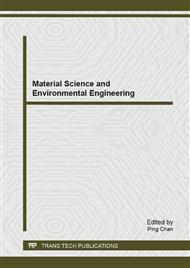[1]
Mouritz A.P. Review of applications for advanced three dimensional fiber textile composites[J]. Composites: Part A, 1999, 30: 1445-l46.
DOI: 10.1016/s1359-835x(99)00034-2
Google Scholar
[2]
Crane R.M., Macander A.B. [J]. Naval engineers journal, 1984, 96(6): 52—56.
Google Scholar
[3]
Tao xiaoming, Xi xingjuan, Gao guanxu, The textile structural composites [M]. Science press. 2001, 1~9. (In Chinese).
Google Scholar
[4]
Zhongde Shan, Shaoyan Qin, Qian Liu, Feng Liu, Key Manufacturing Technology & Equipment on Energy Saving and Emissions Reduction in Mechanical Equipment Industry. International Symposium on Green Manufacturing and Applications. (2011).
DOI: 10.1007/s12541-012-0143-y
Google Scholar
[5]
Ghiorse S R. . Effect of Void Content on The Mechanical Properties of Carbon/ Epoxy Laminates SAM PE Q. , 1993, 24( 2) : 54~ 59.
Google Scholar
[6]
Bow ies K J. Frimpong S J. Void Effects on the Inter laminar Shear Strength of Unidirectional Graphite- Fiber- Reinforced Composites. Composite Mater. , 1992, 26(10) : 1487~ 1509.
DOI: 10.1177/002199839202601006
Google Scholar
[7]
A G Every, Y Tzou, D P H Hasselman, R Raj. The Effect of particle size on the thermal conductivity of ZnS/diamond composites[J]. Acts Metall Mater, 1992, 40: 123.
DOI: 10.1016/0956-7151(92)90205-s
Google Scholar
[8]
TrPvino L, Rupei K, Young W B, et al. Analysis of resin injection moulding in moulds with preplaced fiber mats I: permeability and compressibility measurements[j]. Polymer Composites, 1991, 12(1): 20-29.
DOI: 10.1002/pc.750120105
Google Scholar
[9]
Ahn K J, Letterman L. Braided to net section graphite/epoxy composite shapes [J]. 1985(6): 589-607.
Google Scholar
[10]
Blest D C, McKee S. Resin infusion technology for the autoclave process. P. Marshall [J]. Compos Sci, 1999, 59: 2297.
DOI: 10.1016/s0266-3538(99)00084-6
Google Scholar
[11]
N. Patel and L. James Lee. Modeling of Formation and Removal in Liquid Composite Molding. Part I: Wet ability Analysis. Polymer Composites. 1996, 17(1): 104.
Google Scholar


